Abstract
The ribonucleic acid (RNA) synthesized at specified intervals during infection of Escherichia coli K-12 by bacteriophage T4 was hybridized to denatured E. coli or T4 deoxyribonucleic acids (DNA). The reactions were performed under conditions that maximized the yield and at RNA/DNA inputs such that excess DNA sites were available for all RNA species. Most of the RNA synthesized at any time during the first 3 min of infection was host-specific. The fraction declined rapidly as infection progressed; host RNA represented about half that made between 3 and 4 min. It is unlikely that this represented RNA synthesized by bacteria that had escaped infection, as judged by the kinetics of adsorption and killing as well as by the rapid inhibition of β-galactosidase induction after infection. The nature of the host RNA was also examined. Part of the RNA synthesized during infection of cells rendered sensitive to actinomycin was stable in the presence of this inhibitor. This RNA was essentially all host-specific and it sedimented as ribosomal and transfer RNA; most of the ribosomal RNA was incorporated into 30S and 50S ribosomes. Hybridization analyses suggested that unstable E. coli messenger RNA was also synthesized for several minutes after infection; the proportion of unstable to stable host RNA synthesized appeared to be similar in infected and uninfected cells. Thus, it is concluded that significant amounts of E. coli RNA are synthesized during the first minutes of T4 infection. Host messenger RNA initiated after infection may not be translated into enzymes; alternatively, it is conceivable that continued bacterial messenger RNA synthesis only reflects the completion of transcription of operons whose reading was initiated prior to infection.
Full text
PDF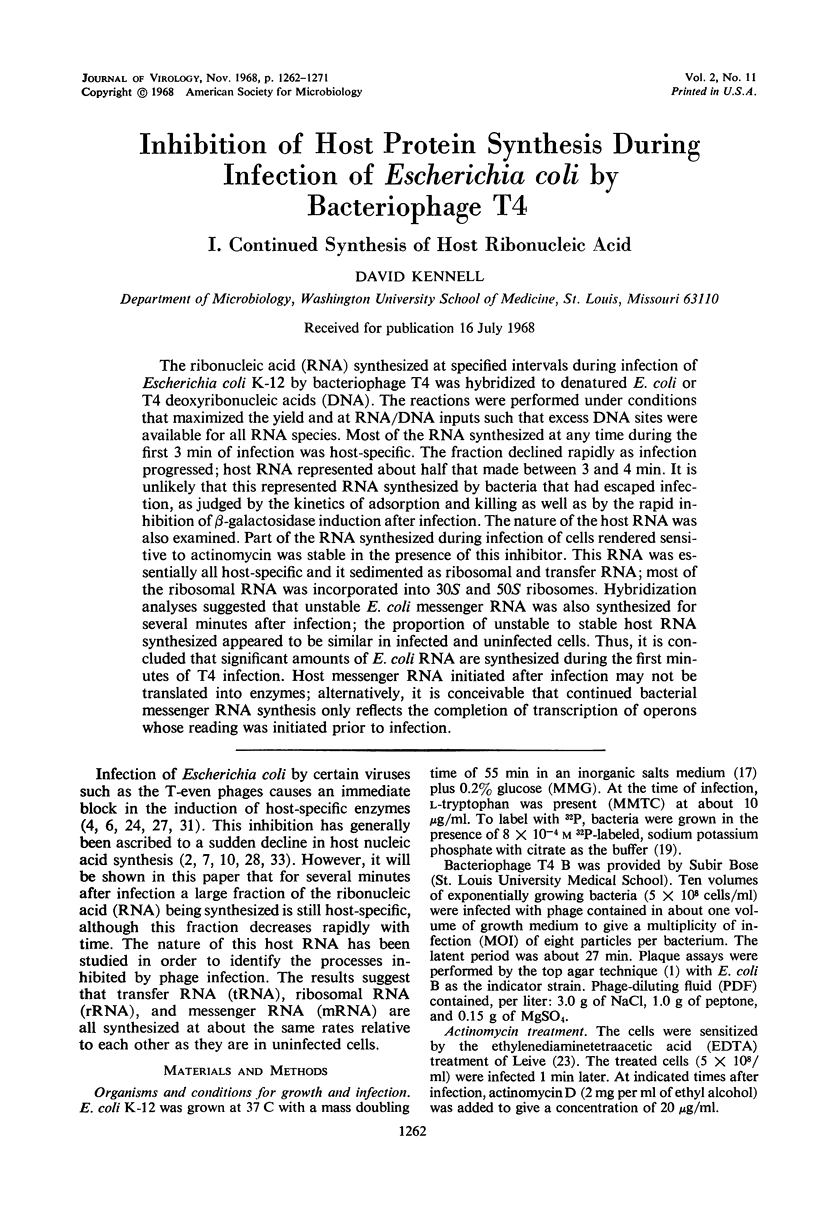
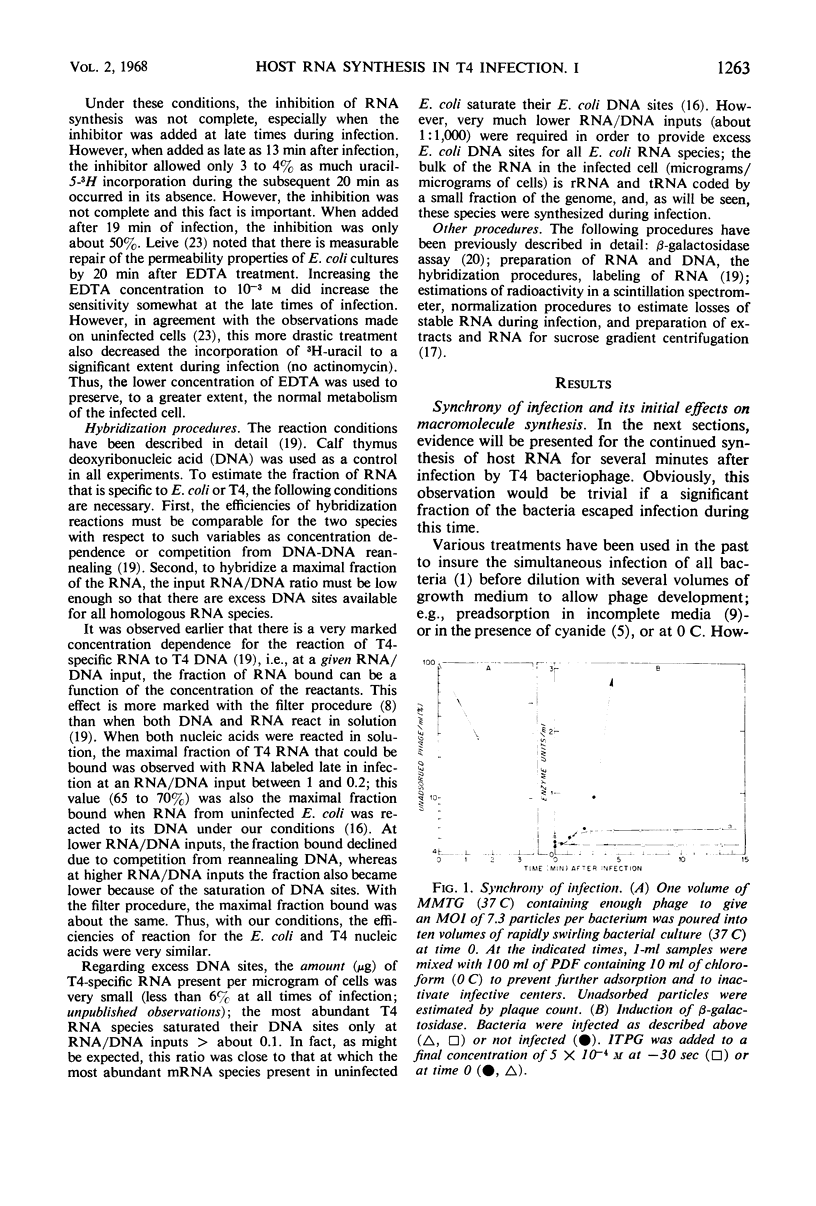


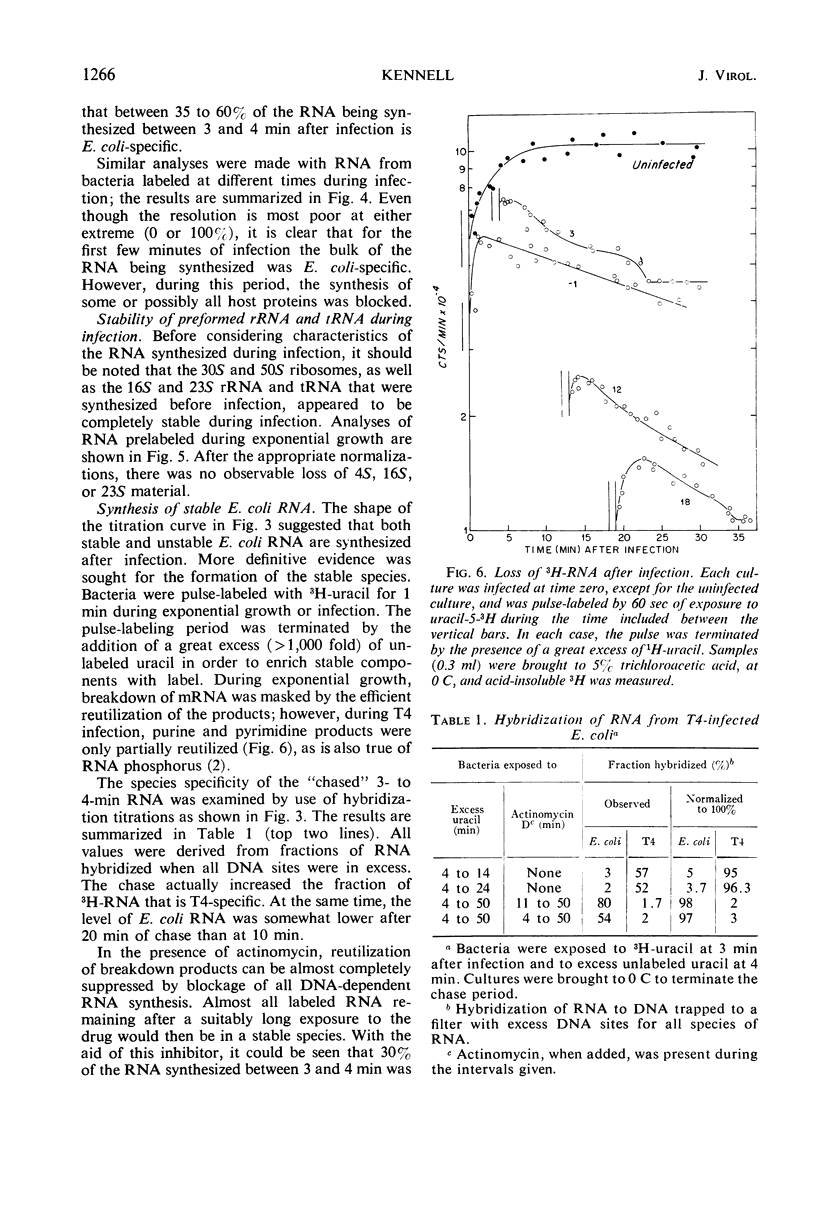

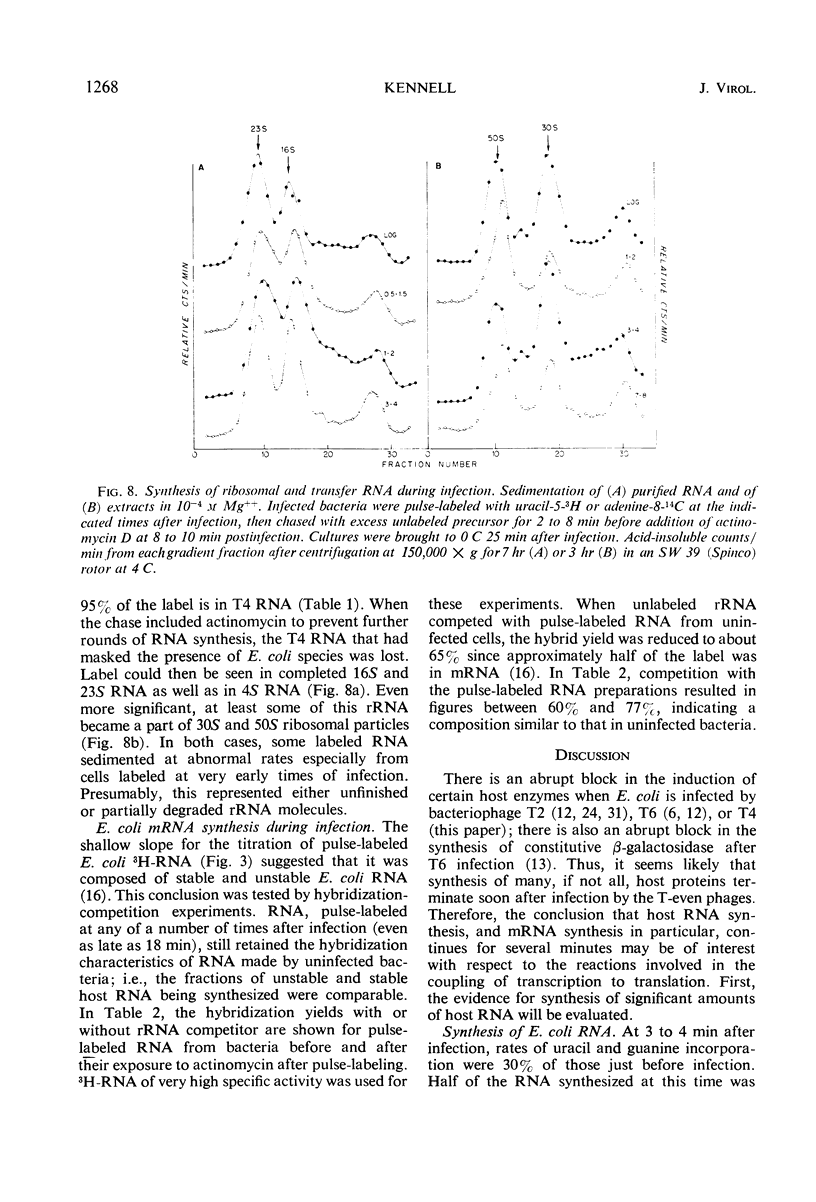

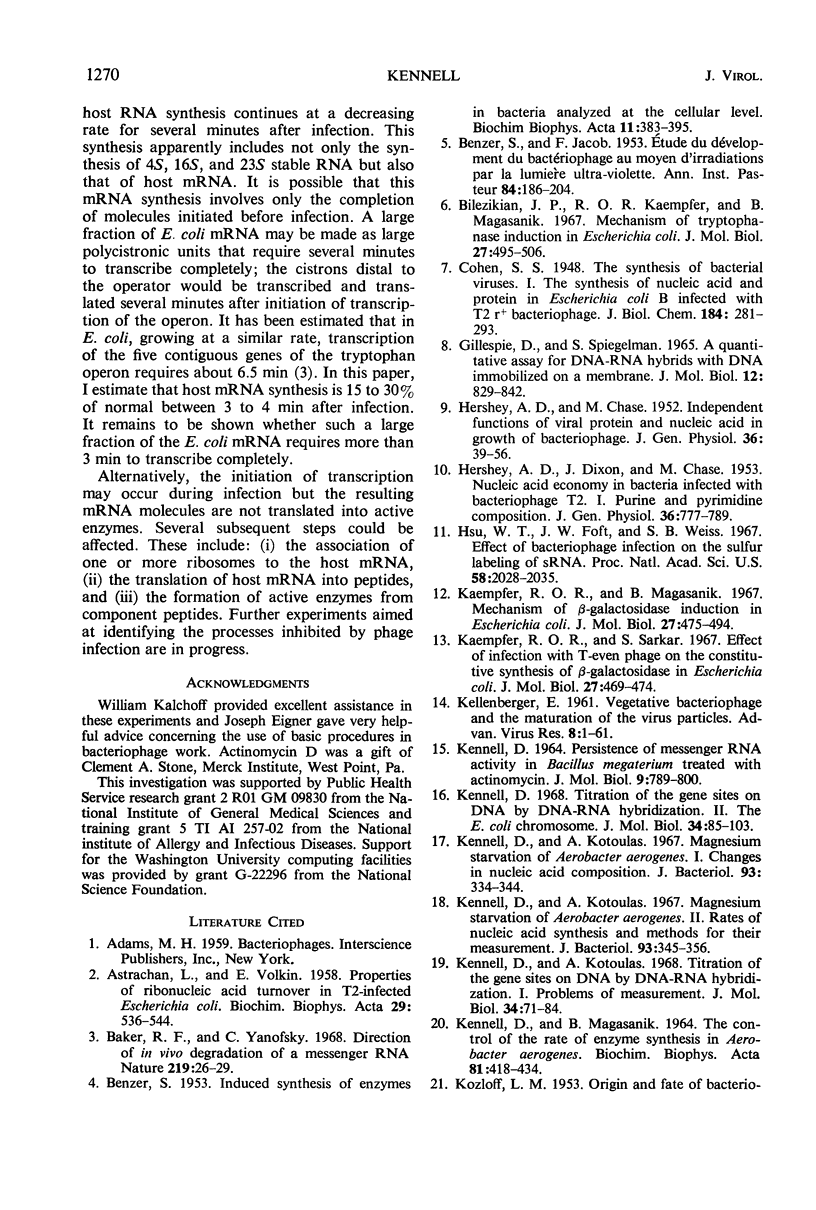
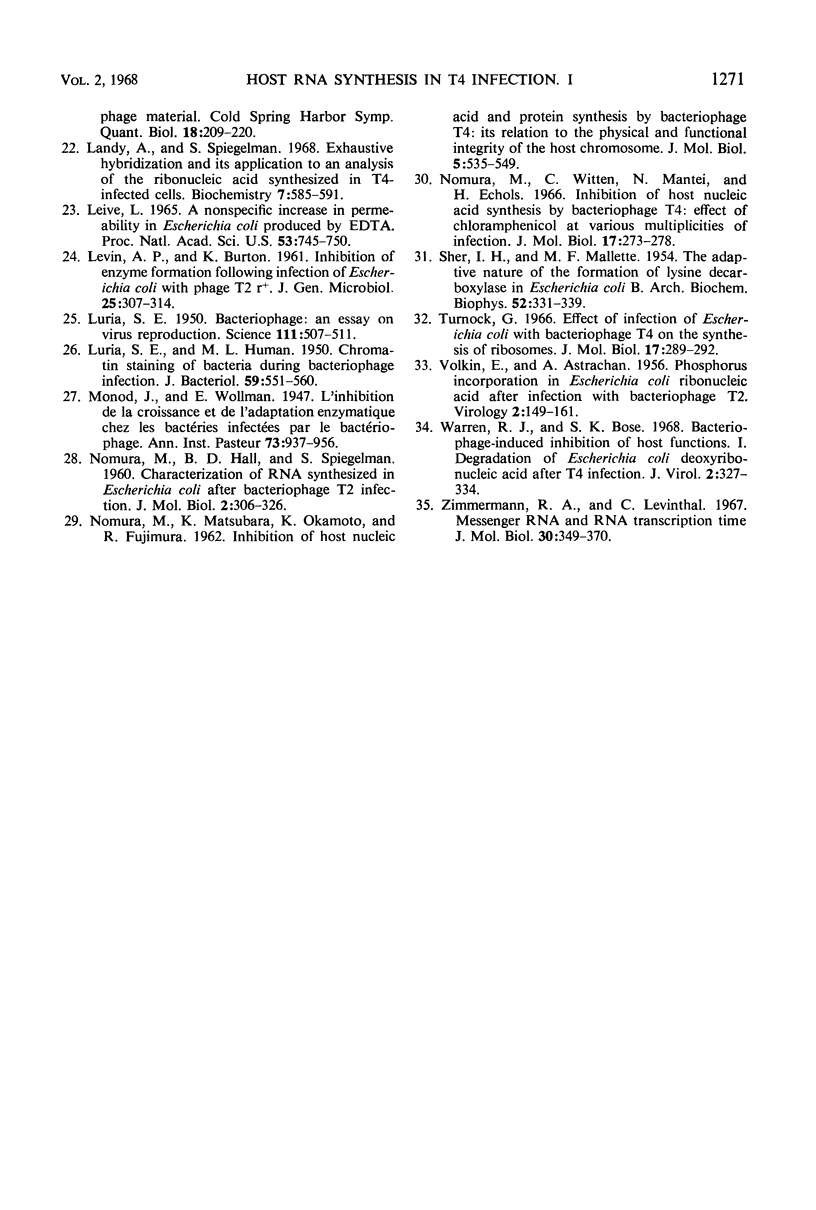
Selected References
These references are in PubMed. This may not be the complete list of references from this article.
- ASTRACHAN L., VOLKIN E. Properties of ribonucleic acid turnover in T2-infected Escherichia coli. Biochim Biophys Acta. 1958 Sep;29(3):536–544. doi: 10.1016/0006-3002(58)90010-6. [DOI] [PubMed] [Google Scholar]
- BENZER S. Induced synthesis of enzymes in bacteria analyzed at the cellular level. Biochim Biophys Acta. 1953 Jul;11(3):383–395. doi: 10.1016/0006-3002(53)90057-2. [DOI] [PubMed] [Google Scholar]
- BENZER S., JACOB F. Etude du développement du bactériophage au moyen d'irradiations par la lumière ultra-violette. Ann Inst Pasteur (Paris) 1953 Jan;84(1):186–204. [PubMed] [Google Scholar]
- Baker R. F., Yanofsky C. Direction of in vivo degradation of a messenger RNA. Nature. 1968 Jul 6;219(5149):26–29. doi: 10.1038/219026a0. [DOI] [PubMed] [Google Scholar]
- Bilezikian J. P., Kaempfer R. O., Magasanik B. Mechanism of tryptophanase induction in Escherichia coli. J Mol Biol. 1967 Aug 14;27(3):495–506. doi: 10.1016/0022-2836(67)90054-x. [DOI] [PubMed] [Google Scholar]
- Gillespie D., Spiegelman S. A quantitative assay for DNA-RNA hybrids with DNA immobilized on a membrane. J Mol Biol. 1965 Jul;12(3):829–842. doi: 10.1016/s0022-2836(65)80331-x. [DOI] [PubMed] [Google Scholar]
- HERSHEY A. D., CHASE M. Independent functions of viral protein and nucleic acid in growth of bacteriophage. J Gen Physiol. 1952 May;36(1):39–56. doi: 10.1085/jgp.36.1.39. [DOI] [PMC free article] [PubMed] [Google Scholar]
- HERSHEY A. D., DIXON J., CHASE M. Nucleic acid economy in bacteria infected with bacteriophage T2. I. Purine and pyrimidine composition. J Gen Physiol. 1953 Jul;36(6):777–789. doi: 10.1085/jgp.36.6.777. [DOI] [PMC free article] [PubMed] [Google Scholar]
- Hsu W. T., Foft J. W., Weiss S. B. Effect of bacteriophage infection on the sulfur-labeling of sRNA. Proc Natl Acad Sci U S A. 1967 Nov;58(5):2028–2035. doi: 10.1073/pnas.58.5.2028. [DOI] [PMC free article] [PubMed] [Google Scholar]
- KELLENBERGER E. Vegetative bacteriophage and the maturation of the virus particles. Adv Virus Res. 1961;8:1–61. doi: 10.1016/s0065-3527(08)60682-x. [DOI] [PubMed] [Google Scholar]
- KENNELL D., MAGASANIK B. THE CONTROL OF THE RATE OF ENZYME SYNTHESIS IN AEROBACTER AEROGENES. Biochim Biophys Acta. 1964 Mar 9;81:418–434. doi: 10.1016/0926-6569(64)90127-0. [DOI] [PubMed] [Google Scholar]
- KENNELL D. PERSISTENCE OF MESSENGER RNA ACTIVITY IN BACILLUS MEGATERIUM TREATED WITH ACTINOMYCIN. J Mol Biol. 1964 Sep;9:789–800. doi: 10.1016/s0022-2836(64)80185-6. [DOI] [PubMed] [Google Scholar]
- KOZLOFF L. M. Origin and fate of bacteriophage material. Cold Spring Harb Symp Quant Biol. 1953;18:209–220. doi: 10.1101/sqb.1953.018.01.032. [DOI] [PubMed] [Google Scholar]
- Kaempfer R. O., Magasanik B. Mechanism of beta-galactosidase induction in Escherichia coli. J Mol Biol. 1967 Aug 14;27(3):475–494. doi: 10.1016/0022-2836(67)90053-8. [DOI] [PubMed] [Google Scholar]
- Kennel D. Titration of the gene sites on DNA by DNA-RNA hybridization. II. The Escherichia coli chromosome. J Mol Biol. 1968 May 28;34(1):85–103. doi: 10.1016/0022-2836(68)90236-2. [DOI] [PubMed] [Google Scholar]
- Kennell D., Kotoulas A. Magnesium starvation of Aerobacter aerogenes. I. Changes in nucleic acid composition. J Bacteriol. 1967 Jan;93(1):334–344. doi: 10.1128/jb.93.1.334-344.1967. [DOI] [PMC free article] [PubMed] [Google Scholar]
- Kennell D., Kotoulas A. Magnesium starvation of Aerobacter aerogenes. II. Rates of nucleic acid synthesis and methods for their measurement. J Bacteriol. 1967 Jan;93(1):345–356. doi: 10.1128/jb.93.1.345-356.1967. [DOI] [PMC free article] [PubMed] [Google Scholar]
- Kennell D., Kotoulas A. Titration of the gene sites on DNA by DNA-RNA hybridization. I. Problem of measurement. J Mol Biol. 1968 May 28;34(1):71–84. doi: 10.1016/0022-2836(68)90235-0. [DOI] [PubMed] [Google Scholar]
- LEIVE L. A NONSPECIFIC INCREASE IN PERMEABILITY IN ESCHERICHIA COLI PRODUCED BY EDTA. Proc Natl Acad Sci U S A. 1965 Apr;53:745–750. doi: 10.1073/pnas.53.4.745. [DOI] [PMC free article] [PubMed] [Google Scholar]
- LEVIN A. P., BURTON K. Inhibition of enzyme formation following infection of Escherichia coli with phage T2r. J Gen Microbiol. 1961 Jun;25:307–314. doi: 10.1099/00221287-25-2-307. [DOI] [PubMed] [Google Scholar]
- LURIA S. E. Bacteriophage: an essay on virus reproduction. Science. 1950 May 12;111(2889):507–511. doi: 10.1126/science.111.2889.507. [DOI] [PubMed] [Google Scholar]
- LURIA S. E., HUMAN M. L. Chromatin staining of bacteria during bacteriophage infection. J Bacteriol. 1950 Apr;59(4):551–560. doi: 10.1128/jb.59.4.551-560.1950. [DOI] [PMC free article] [PubMed] [Google Scholar]
- Landy A., Spiegelman S. Exhaustive hybridization and its application to an analysis of the ribonucleic acid synthesized in T4-infected cells. Biochemistry. 1968 Feb;7(2):585–591. doi: 10.1021/bi00842a011. [DOI] [PubMed] [Google Scholar]
- Nomura M., Witten C., Mantei N., Echols H. Inhibition of host nucleic acid synthesis by bacteriophage T4: effect of chloramphenicol at various multiplicities of infection. J Mol Biol. 1966 May;17(1):273–278. doi: 10.1016/s0022-2836(66)80107-9. [DOI] [PubMed] [Google Scholar]
- SHER I. H., MALLETTE M. F. The adaptive nature of the formation of lysine decarboxylase in Escherichia coli B. Arch Biochem Biophys. 1954 Oct;52(2):331–339. doi: 10.1016/0003-9861(54)90131-9. [DOI] [PubMed] [Google Scholar]
- Turnock G. Effect of infection of Escherichia coli with bacteriophage T4 on the synthesis of ribosomes. J Mol Biol. 1966 May;17(1):289–292. doi: 10.1016/s0022-2836(66)80110-9. [DOI] [PubMed] [Google Scholar]
- VOLKIN E., ASTRACHAN L. Phosphorus incorporation in Escherichia coli ribo-nucleic acid after infection with bacteriophage T2. Virology. 1956 Apr;2(2):149–161. doi: 10.1016/0042-6822(56)90016-2. [DOI] [PubMed] [Google Scholar]
- Warren R. J., Bose S. K. Bacteriophage-induced inhibition of host functions. I. Degradation of Escherichia coli deoxyribonucleic acid after T4 infection. J Virol. 1968 Apr;2(4):327–334. doi: 10.1128/jvi.2.4.327-334.1968. [DOI] [PMC free article] [PubMed] [Google Scholar]
- Zimmermann R. A., Levinthal C. Messenger RNA and RNA transcription time. J Mol Biol. 1967 Dec 14;30(2):349–370. [PubMed] [Google Scholar]


